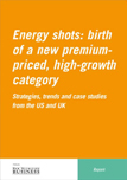
Energy shots: birth of a new premium-priced, high-growth category: Strategies, trends and case studies from the US and UK
Mellentin, Julian
Such is the value to consumers of the proposition of a daily dose of energy with no added sugar that in the US alone this new category has soared to over $350 million in retail sales in less than two years - despite recession and despite selling at a massive 400% price premium over "mainstream" energy drinks such as Red Bull! This unique 40-page report uses detailed brand sales data, comparisons of product pricing and advertising messages and claims, as well assix detailed case studies, to explain how, in both the US and the UK, energy shots have achieved the impossible. Based on interviews with executives at all the leading companies in this new category as well as beverage industry experts the report sets out brief and practical guidelines for anyone else looking to replicate this success elsewhere. We summarise: success factors, and common causes of failure common lessons for pricing, positioning and brandingkey lessons in communicating benefits A key aspect of this new category in energy drinks is that it has been developed to meet the needs of all those people who are not served by the current market, where most consumers are 14-25-year-olds and male. The adrenaline-rush, all-male approach of most energy drinkbrands was guaranteed to alienate most consumers. The leading brand in the US market with a 70% share, 5-Hour Energy, decided from the outset that it wasn't going to aim at the "14-year-old skate punks". Instead it aimed at mothers, office workers and in fact any mature consumer struggling with a demanding day, delivering them a brand with a "no added sugar" promise. Outside the US there's an opportunity in most countries to create a new brand by targeting similar groups of consumers whose need for healthy energy is still unmet. There are a wealth of opportunities throughout Europe - where energy drinks are a category least likely to be affected by the EU's restrictive health claims regulation. There are also opportunities for companies that are fast to market in Australia, parts of South America and the Middle East. INDICE: Executive summary - Some rules for success in the new energy shotcategory The US market: brand sales, market data and forecasts - Market data - Super-premium pricing - Case study - Could 5-Hour Energy be the next Red Bull? - Case study - Zen shot promises "natural energy" - Can the big brandscompete? - Case study - Red Bull moves into energy shots - Case study - Coca-Cola's NOS power shot The European market: brand sales, market data and forecasts - Market data - Opportunities in Europe - Super-premium pricing - Case study - Quick Energy - Case study - Powershot - Case study - An opportunity for dairy? Brand identity, marketing communications and the target consumer - Marketing messages defined by "sugar-free" and "no crash" - Success from attracting new consumers to energy Seven strategy lessons from the energy shotcategory - Lesson 1: New category creation and disruptive innovation is the most successful strategy - Lesson 2: Provide a benefit that consumers can feel - Lesson 3: Focus on one benefit, one brand - Lesson 4: Offer I-nutrition- Lesson 5: Innovate in packaging - Lesson 6: Make your product premium-priced - Lesson 7: Look to Asian ideas
- ISBN: 978-1-906297-27-5
- Editorial: Woodhead
- Encuadernacion: Rústica
- Páginas: 40
- Fecha Publicación: 01/07/2009
- Nº Volúmenes: 1
- Idioma: Inglés
